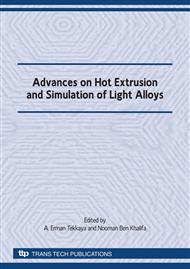[1]
E. D. Sweet et al.: Effects of Extrusion Parameters on Coarse Grain Surfache Layer in 6xxx Series Extrusions, ET (2004).
Google Scholar
[2]
M. Schikorra, L. Donati, L. Tomesani, A.E. Tekkaya: Microstructure analysis of aluminum extrusion: Prediction of microstructure on AA6060 alloy, Journal of Materials Processing Technology, Volume 201 (2008), pp.156-162.
DOI: 10.1016/j.jmatprotec.2007.11.160
Google Scholar
[3]
H. Mecking , U.F. Kocks: Kinetics of flow and strain-hardening, Acta Metallurgica, Volume 29 (1981), pp.1865-1875.
DOI: 10.1016/0001-6160(81)90112-7
Google Scholar
[4]
H.J. McQueen, W. Blum: Dynamic recovery: sufficient mechanism in the hot deformation of Al (<99. 99), Materials Science and Engineering A, Volume 290(2000), pp.95-107.
DOI: 10.1016/s0921-5093(00)00933-3
Google Scholar
[5]
H.J. McQueen: Deficiencies in Continuous DRX Hypothesis as a Substitute for DRX Theory, Materials Forum, Volume 28 (2004), pp.351-356.
Google Scholar
[6]
S. Gourdet, F. Montheillet: A model of continuous dynamic recrystallization, Acta Materialia, Volume 51 (2003), pp.2685-2699.
DOI: 10.1016/s1359-6454(03)00078-8
Google Scholar
[7]
W. Blum, Q. Zhu, R. Merkel, H.J. McQueen: Geometric dynamic recrystallization in hot torsion of Al-5Mg-0. 6Mn (AA5083), Materials Science and Engineering A, Volume 205 (1996), pp.23-30.
DOI: 10.1016/0921-5093(95)09990-5
Google Scholar
[8]
M. Bakhshi-Jooybari: A theoretical and experimental study of friction in metal forming by the use of the forward extrusion process, Journal of Materials Processing Technology, Volume 125-126 (2002), pp.369-374.
DOI: 10.1016/s0924-0136(02)00343-6
Google Scholar
[9]
M. Schikorra, L. Donati, L. Tomesani, M. Kleiner: The role of friction in the extrusion of AA6060 aluminum alloy, process analysis and monitoring, Journal of Materials Processing Technology, Volume 191 (2007), pp.288-292.
DOI: 10.1016/j.jmatprotec.2007.03.096
Google Scholar
[10]
S. Kalz: Numerische Simulation des Strangpresse mit Hilfe der Methode der finiten Elemente, Dr. -Ing. Dissertation, Institut für bildsame Formgebung, Aachen, IBSN 3-8265-9718-4 (2001).
Google Scholar
[11]
T. Kloppenborg, M. Schikorra, M. Schomäcker, A.E. Tekkaya: Numerical Optimization of Bearing Length in Composite Extrusion Processes, Proceedings of International Workshop and Extrusion Benchmark, Bologna (Italy), 20. -21. Sept. 2007, Zürich: Trans Tech Publications Ltd (2008).
DOI: 10.4028/www.scientific.net/kem.367.47
Google Scholar
[12]
G. Petzow: Metallographisches, Keramographisches, Plastographisches Ätzen, 6. überarbeitete Auflage, Nachdruck, September 2006, Borntraeger, p.72, IBSN 013000170.
DOI: 10.1002/maco.19940451212
Google Scholar


